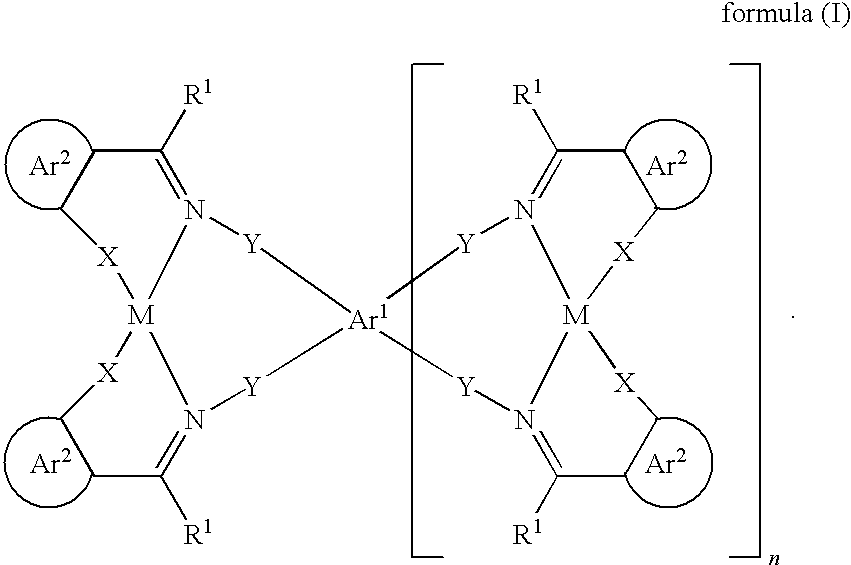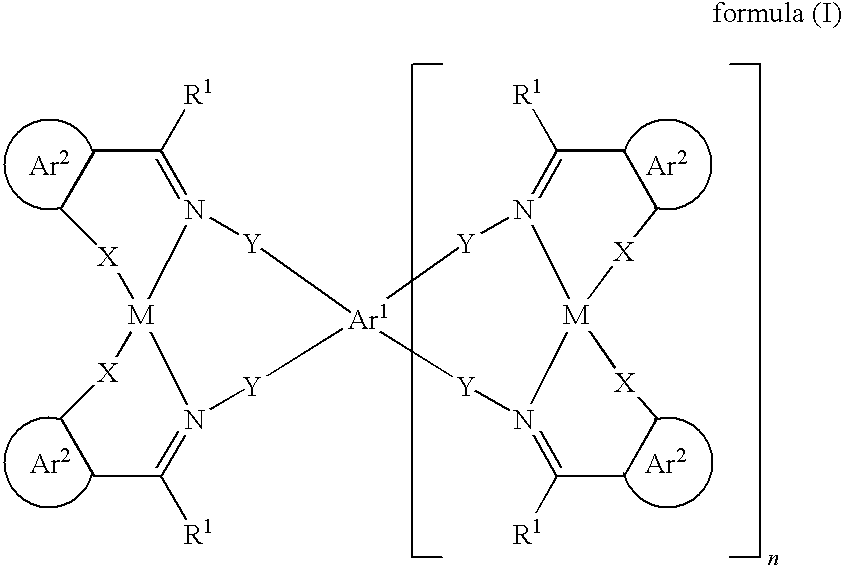Organic electroluminescent devices comprising azomethine-metal complexes
a technology of azomethine and metal complexes, which is applied in the direction of luminescent compositions, thermoelectric devices, chemistry apparatuses and processes, etc., can solve the problems of unsatisfactory physical properties of phosphorescent oleds, low power efficiency, and inability to meet the requirements of phosphorescent oleds, so as to achieve stable hydrolysis, good thermal stability, and high glass transition temperature
- Summary
- Abstract
- Description
- Claims
- Application Information
AI Technical Summary
Benefits of technology
Problems solved by technology
Method used
Image
Examples
example 1
Synthesis of 3′,2″-diamino-p-quaterphenyl
a) Preparation of 3′,2″-dinitro-p-quaterphenyl
[0070]
[0071]2.4 g (2.1 mmol) of Pd(PPh3)4 are added to a well-stirred, degassed suspension of 18.8 g (154.5 mmol) of phenylboronic acid, 30 g (74.6 mmol) of 2,5-dibromonitrobenzene and 53 g (212.7 mmol) of potassium carbonate in a mixture of 300 ml of water and 300 ml of THF, and the mixture is heated under reflux for 20 hours. After cooling, the organic phase is separated off, washed three times with 200 ml of water and once with 200 ml of saturated sodium chloride solution, dried over magnesium sulfate and evaporated to dryness in vacuo in a rotary evaporator. The grey residue is recrystallised from hexane. The deposited crystals are filtered off with suction, washed with a little MeOH and dried in vacuo; yield: 23 g, 80% of theory; purity: 99.2% according to HPLC.
b) Preparation of 3′,2″-diamino-p-quaterphenyl
[0072]
[0073]16.6 g (42 mmol) of 3′,2″-dinitro-p-quaterphenyl and 1.99 g of Pd / C (10%) a...
example 2
General Synthetic Procedure for Metal Complexes
[0074]There are two general methods for the preparation of the complexes:
A) Reaction of aromatic amines with metal salts and o-hydroxyaldehyde or o-hydroxyketone;
B) Reaction of Schiff bases of the aromatic amines with metal salts.
[0075]Method A can be used if the by-product (H2O) does not destroy the complex to be prepared. If this complex is moisture-sensitive or if the imine formation is not quantitative, method B is suitable.
[0076]
[0077]260 mmol of the o-hydroxyaldehyde or o-hydroxyketone are added to a solution of 121 mmol of aromatic diamine in 1000 ml of dry methanol and 100 ml of triethylamine. 127 mmol of metal salt, for example zinc acetate, are subsequently added to the mixture, which is stirred at room temperature for 24 hours, then filtered and washed with cold methanol. The product is purified by recrystallisation.
[0078]
i) Ligand Synthesis
[0079]The ligand synthesis is carried out using azeotropic distillation for removing t...
example 3
Synthesis of Zn Complex (1)
[0081]
[0082]The synthesis of [[2,2′-[[1,1′-biphenyl]-2,2′-diylbis(nitrilomethylidyne)]bis[phenolato]](2-)—N,N′,O,O′]zinc was described for the first time by method (B) in Journal of the Chemical Society, Dalton Transactions: Inorganic Chemistry 1996, 2835-2838. The complex obtained by this method contains the free ligand as by-product, which makes preparation of the complex in a purity >99% more difficult. Method (A) described above, starting from 8.9 g (48 mmol) of 2,2′-diaminobiphenyl, 17 g (140 mmol) of 2-hydroxybenzaldehyde, 8.8 g (48 mmol) of zinc acetate dihydrate and 40 ml of triethylamine in 400 ml of absolute MeOH, gives the complex in a very high yield and in a purity of >99.9%. After 24 hours, the precipitated solid is washed with cold methanol, dried in vacuo and subsequently recrystallised from absolute EtOH under a protective gas, giving 21.5 g (47 mmol) of a crystalline solid. The overall yield is 98% (Tg=152.0° C., Tm=280.0° C.).
PUM
 Login to View More
Login to View More Abstract
Description
Claims
Application Information
 Login to View More
Login to View More - R&D
- Intellectual Property
- Life Sciences
- Materials
- Tech Scout
- Unparalleled Data Quality
- Higher Quality Content
- 60% Fewer Hallucinations
Browse by: Latest US Patents, China's latest patents, Technical Efficacy Thesaurus, Application Domain, Technology Topic, Popular Technical Reports.
© 2025 PatSnap. All rights reserved.Legal|Privacy policy|Modern Slavery Act Transparency Statement|Sitemap|About US| Contact US: help@patsnap.com



